- 1School of Geosciences, Yangtze University, Wuhan, China
- 2Hubei Cooperative Innovation Center of Unconventional Oil and Gas, Yangtze University, Wuhan, China
Under the promotion of exploration and development for shale oil and gas, marine shale has become a hotspot of fine-grained sedimentary studies in China. Paleo-environment reconstruction has always been an important aim, especially for black shale. Based on a large number of samples collected from Wufeng and Longmaxi Formations of two field sections in western Hubei and eastern Chongqing, this study compares the vertical variations in total organic carbon content, quartz/clay mineral value, and trace element compositions of these two profiles to reflect the paleo-environment changes from the latest Ordovician to the earliest Silurian. The results show that during the later Ordovician period, when Wufeng Formation deposited, the study area experienced a water depth change from relative deep facies to shallow marine, and paleo-redox changed from oxygen rich to anoxic, and even euxinic, followed by the content of oxygen increase. When the Guanyinqiao Bed deposited, the basin suddenly became shallower, and the deposition environment changed to be oxygen enriched for high water energy, circulating oxygen enriched. In the earliest stage Silurian, when the Longmaxi Formation formed, and the paleo-water also suffered several changes of sea level, and the paleo-environment also changed from anoxic to oxic. These changes can correspond to the third-forth order sequences well.
Introduction
Black shale is a kind of special sedimentary rock with enriched organic matter, which may contain shale oil and gas. With the outbreak of shale oil and gas revolution in the United States around 2010, black shale has become a hotspot of sedimentary studies in the world, especially in China (Xian et al., 2014). The Fuling shale gas field in Chongqing City has produced more than 60 billion cubic meters of shale gas from January to November in 2020, which has become the largest shale gas field outside of North America (sinopecnews, 2020). Currently, researchers on shale or shale oil and gas mainly focus on hydrocarbon generation potential (Zou et al., 2010; Yan et al., 2016), sedimentary microfacies (Li et al., 2013; Wang et al., 2015; Yao et al., 2016; Yi, 2020), sedimentary environment (Deng et al., 2018; Zhu, 2019), reservoir characteristics (Wang et al., 2017; Jiao et al., 2018; Xie, 2020), and preservation conditions (Guo, 2016; Gao et al., 2019) of the Qiongzhusi Formation of Lower Cambrian and Wufeng–Longmaxi Formations of the Upper Ordovician to the Lower Silurian in the Sichuan Basin of China.
Paleo-environmental reconstruction plays significant role not only in regional basin evolution research but also in global petrology study (Zhong et al., 2015; Li et al., 2017). Both lacustrine and marine shales have been well studied with multiple proxies for paleo-environmental reconstruction. Some scholars have studied the paleo-environment of black shale, mainly focusing on lacustrine mudstone or shale. Zheng et al. (2015) and Sun, (2016) discussed the relative changes in the water level of Zhangjiatan shale and Carboniferous–Permian coal shale in Ordos Basin by using Rb/K value and REE concentration; Li et al. (2017) and Zhu et al. (2016) analyzed the paleo-water depth changes in lower Cretaceous lacustrine shale in Changling faulted depression of Songliao Basin and shale in Dongying sag of Bohai Bay Basin by using Fe/Mn and (Al + Fe)/(Ca + Mg) ratios, respectively. Douglas (1972), Sliter (1972), Robert and Samuel (1978), and Chen (1997) studied the paleo-environment variations according to the abundance and differentiation of planktonic foraminifera in the shelf marginal marine environment of black shale after Silurian; Zhang and Zhang, (2006) analyzed the paleo-environment of Silurian using the degree of negative Ce anomaly in Tarim basin; Li et al. (2005) and He et al. (2013) calculated the paleo-water depth by planktonic foraminifera content in Yingqiong Basin and western South China Sea; Qiu, (2015) pointed out that the paleo-water depth of blocky shale and parallel laminar shale were significantly deeper than that of nonparallel laminar shale by studying the shale of Wufeng–Lower Longmaxi Formation in the eastern margin of Sichuan Basin. Especially, the paleoproductivity and redox conditions of Wufeng–Longmaxi shale, determined by geochemical elements, can determine the thickness and quality of organic-rich shale, which has a certain impact on shale gas production (Zhang et al., 2018). Here we present a comprehensive study with multiple proxies of the black shales from two O–S boundary sections in western Hubei and eastern Chongqing for paleo-environmental reconstructions.
Geological setting
The region between western Hubei Province and eastern Chongqing City is located in the eastern Sichuan Basin. Its structure place belongs to the fold belt of eastern Sichuan province and is located in the transition zone of slot-block-type fold belt between western Hunan–Hubei Province and eastern Sichuan province (Guo et al., 2017). In structure, the region between western Hubei Province and eastern Chongqing City mainly includes Fangdoushan anticlinorium, Shizhu synclinorium, Qiyueshan anticlinorium, and Lichuan synclinorium, including many anticlines (Figure 1).

FIGURE 1. Geographical location map of the Huangying and Maoba sections (modified after Zhang et al., 2013).
During the Late Ordovician to Early Silurian, the deposits in this area inherited the paleogeographic pattern since the Late Ordovician, showing the characteristics of foreland basin. In addition, the sedimentary environment was mainly shelf deposits in the area between western Hubei Province and eastern boundary of the City of Chongqing City, and the Wufeng–Lower Longmaxi Formation black shale was widely developed (Figure 2). Here, two well-exposed O-S boundary sections, located in Maoba town of Lichuan City and Huaying of Chongqing City, respectively, are studied. On the sections, the boundary succession is composed of the uppermost Linxiang Formation, Wufeng Formation, and basal Longmaxi Formation. The Wufeng Formation is mainly black carbonaceous shale, siliceous carbonaceous shale, and argillaceous shale, and rich in graptolite, while the basal Longmaxi Formation comprises gray black, gray carbonaceous shale, argillaceous shale with silty mudstone, with pyrite, and graptolite enriched (Figure 3). On the top of the Wufeng Formation, a set of black argillaceous limestone with abundant brachiopod fossils is formed, and named the Guanyinqiao Bed in China (Wang et al., 2016). The Guanyinqiao Bed is significant for stratigraphic identification and correlation (Figure 4).
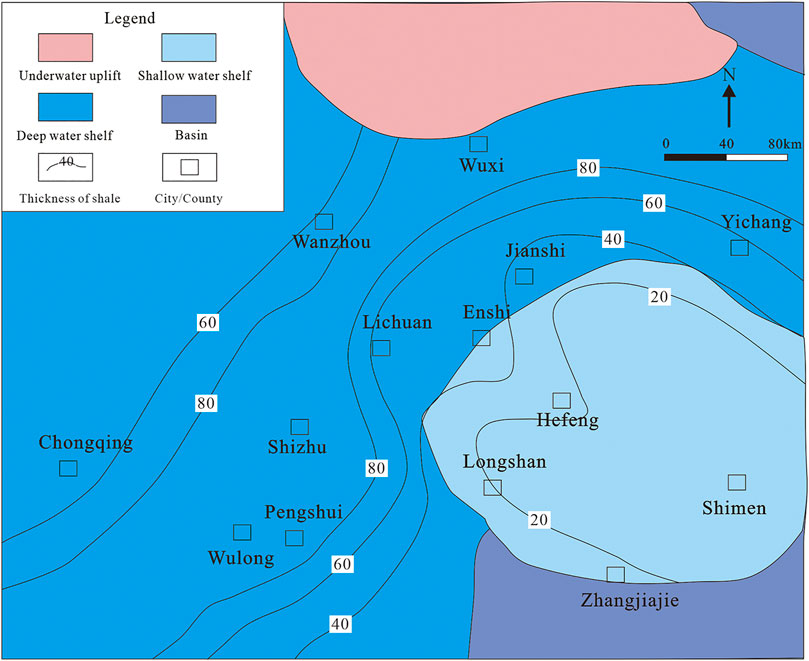
FIGURE 2. Shale thickness and lithofacies paleogeography between the Wufeng–Longmaxi Formations of western Hubei and northeastern Chongqing area (modified after Zhou, et al., 2019).
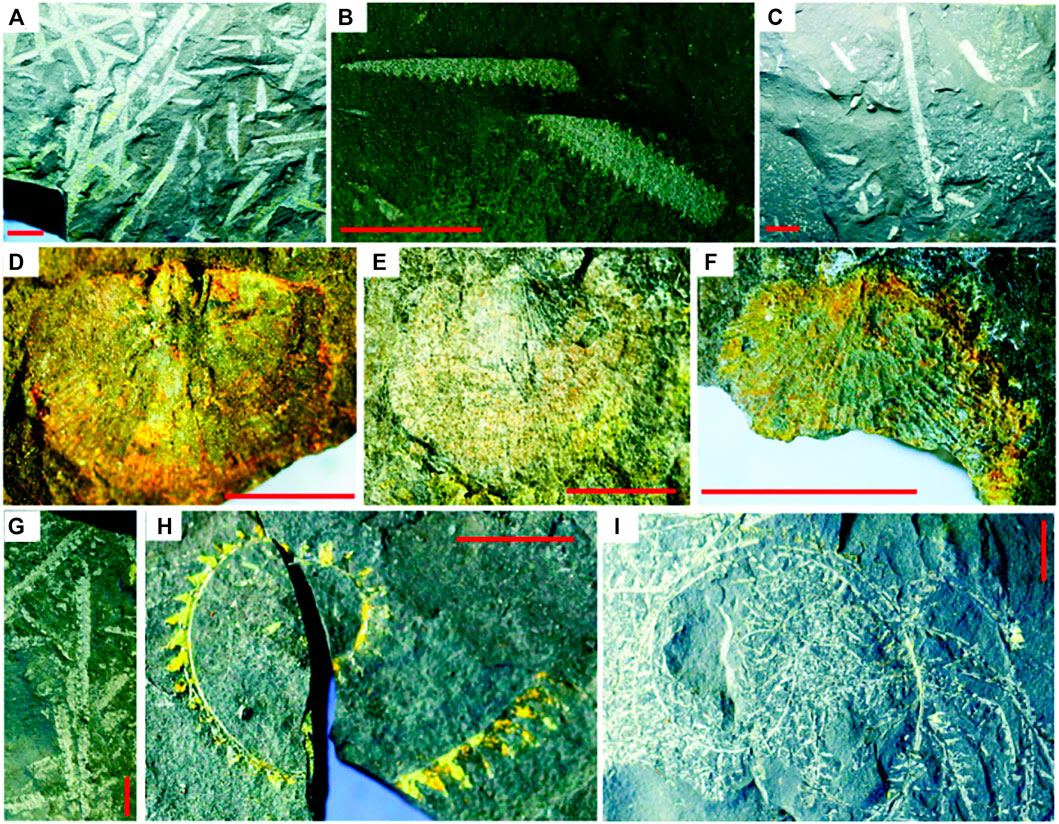
FIGURE 3. Selected fossils of the study sections. (A–C) A large number of graptolite in the Huangying section, Chongqing City. (D–F) Brachiopod fossils found in Guanyingqiao Bed of Huangying section, Chongqing City. (G–I) Graptolites found in the Maoba section, Lichuan City (scale bars are 1 cm in length).
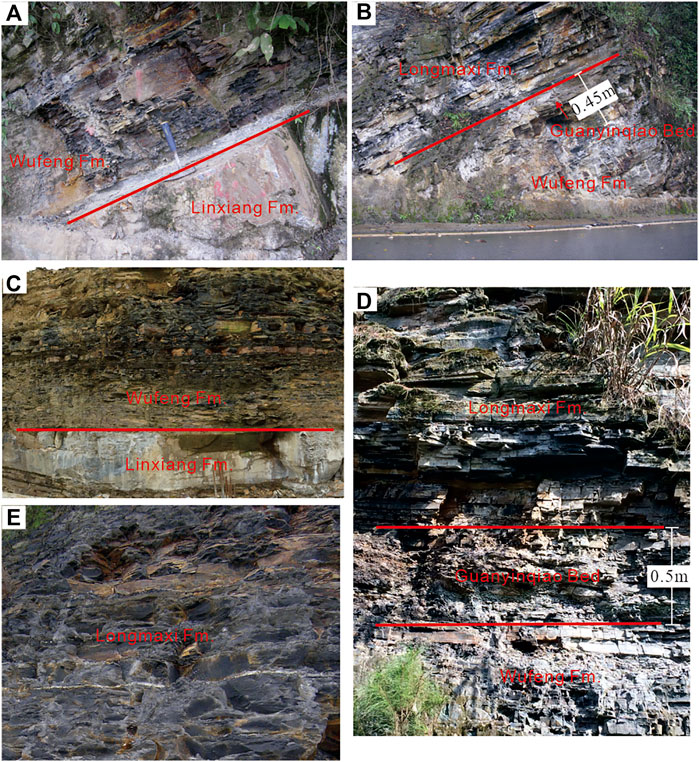
FIGURE 4. Photos of the study sections. (A,B) show the formation boundaries at the Huangying section: the black shales of the Wufeng Formation overlies the carbonates of the Linxiang Formation (A). The Guanyingqiao Bed occurs in the topmost Wufeng Formation, continuously underlying the black shales of the Longmaxi Formation (B). (C,D) show the formation boundaries at the Maoba section: the black shales of the Wufeng Formation overlies the carbonates of the Linxiang Formation (C). The Guanyingqiao Bed (0.5-m thick) occurs in the topmost Wufeng Formation, and the Longmaxi Formation shale overlies continuously upward (D). (E) shows the thick-bedded shale of Maoba section.
Materials and methods
The black rock series of the Wufeng–Lower Longmaxi Formation are common in the whole Yangtze block. Based on a comprehensive field survey in the region of western Hubei Province and eastern boundary of Chongqing City, two representative sections of Wufeng Formation–Lower Longmaxi Formation shale, with well exposure and relatively continuous deposition were chosen. Of these two sections, sedimentary features were recorded, shale samples were studied through coring during the field visit from various fresh cut sections along the Huangying village and Maoba town. Huangying section in Wulong county is measured at 30.41 m vertically, and 32 shale or mudstone samples were collected, whereas in total, 20.02-m thick shale was measured at the Maoba section, with 79 shale or mudstone samples collected.
In order to analyze the paleo-environment of black shale in the Wufeng–Lower Longmaxi Formation, a total of 111 fresh and representative black shale samples were used for geochemical analyses, which was carried out at the Geochemistry Laboratory of Yangtze University, Wuhan, China. The fresh samples were selected for crushing into grains less than 0.075 mm in diameter, and measured in the GB/T19145 2003 standard. Prior to analysis, samples for TOC were treated with acid (HCl) for 24 h to remove inorganic carbon. Meanwhile, those 79 fresh shale samples of the Maoba section were measured by X-ray diffraction method in the laboratory of Research Institute of Exploration and Development, Huabei Oilfield Company, for the whole-rock quantitative mineral analysis. The Ultima IV x-ray diffraction instrument in the laboratory was used according to the SY/T5163 2010 standard that was followed. The other 32 shale samples from Huangying section were tested by the Zhongyuan Oilfield Company laboratory. Representative shale samples (34) were chosen to be measured using the X Series II Plasma Mass spectrometer in Central and South China Mineral Resources Monitoring and Testing Center, Land and Resource Ministry, according to the GB/T14506.30–2010 standard, for test trace element (U, Th, V, Ni, Cr, Co) content.
Results
Lab analysis—total organic carbon content
The total organic carbon content (TOC) test results for 111 Wufeng–Lower Longmaxi Formation shales are summarized in Table 1. The overall shale’s TOC values for Wufeng Formation and Lower Longmaxi Formation in the Huangying section range from 3.26 to 5.43 wt%, and from 2.95 to 5.4 wt%, respectively, and the average values for those two beds are 4.36 and 4.28 wt% as shown in Table 1. Samples from the Guanyinqiao Bed of the Huangying section show organic matter richness of 1.21 wt%. For the Maoba section, the shale’s TOC values for Wufeng Formation and Lower Longmaxi Formation range from 0.25 to 3.2 wt%, and from 0.97 to 3.17 wt%, and the average values for those two beds are 1.61 and 2.48 wt%, respectively. Nevertheless, the TOC value of the Guanyinqiao Bed in the Maoba section is 2.64 wt%, higher than that of Huangying section.

TABLE 1. Summary of total organic carbon content (TOC) values from the results of analyzed samples of two section.
Mineral composition and content
In order to further study fine-grained rocks, it is necessary to divide the lithology lithofacies of shale. In recent years, the classification of shale lithofacies is mostly based on their color, size, structure, composition, heavy mineral percentage, fossil composition, fissility, and organic matter abundance, and so on. Here, the three terminal element method is used to classify the rock types. The lithology is divided based on the content of clay minerals, siliceous minerals and carbonate minerals, especially taking the content of brittle minerals in consideration, to be better suitable for the actual development in gas fields. The x-ray diffraction (XRD) result shows that the black shale in the Wufeng–Longmaxi Formations of Huangying section is mainly composed of quartz, potassium feldspar, plagioclase, calcite, gypsum, siderite, clay minerals, etc., while the minerals in Maoba section include quartz, potassium feldspar, anorthosite, pyrite, clay minerals, etc. In the whole, clay minerals include illite, chlorite, illite/montmorillonite interlayers, and minor amounts of kaolinite, among which illite dominates. Mostly, the shale in the study sections belongs to siliceous shale, and some belongs to argillaceous shale. The lithofacies of the Wufeng Formation shale in Huangying section is CM-1 and S, and the Lower Longmaxi Formation shale is mainly S-2, S-3, and some belongs to M-1 facies. For the Maoba section, both Wufeng Formation and the Lower Longmaxi Formation shale samples belong to S-3 and CM-1 (Figure 5), and the actual exploration results show that the favorable lithofacies for shale development are S-2 and S-3 lithofacies (Gamero-Diaz and Miller, 2012). Also, a new index consisting of a ratio of the quartz and clay minerals (Q/C) is calculated in Figure 6.
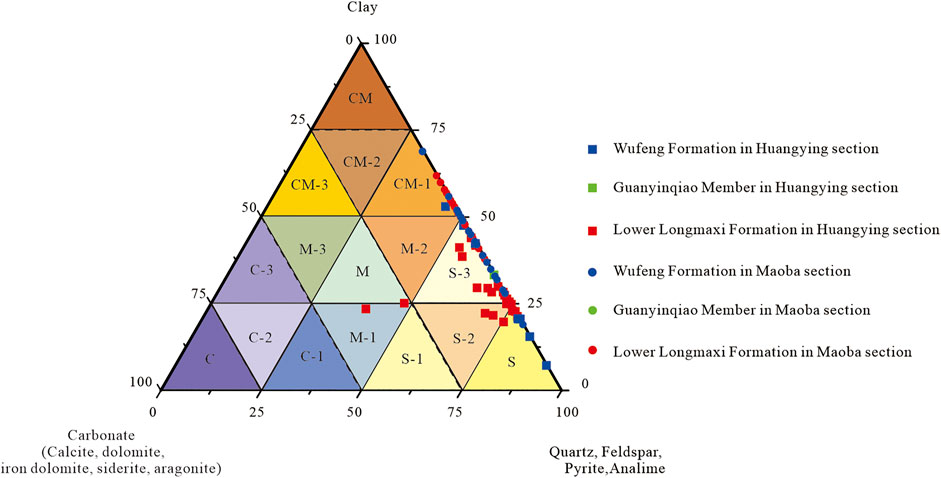
FIGURE 5. Ternary diagram to classify shale in the Wufeng Formation to the Lower Longmaxi Formation in the Huangying section and Maoba section (S, silica-dominated lithotype; S-1, carbonate-rich siliceous shale; S-2, mixed siliceous shale; S-3, clay-rich siliceous shale; C, carbonate-dominated lithotype; C-1, silica-rich carbonate shale; C-2, mixed carbonate shale; C-3, clay-rich carbonate shale; CM, clay-dominated lithotype; CM-1, silica-rich argillaceous shale; CM-2, mixed argillaceous shale; CM-3, carbonate-rich argillaceous shale; M, mixed shale; M-1, carbonate/siliceous shale; M-2, argillaceous/siliceous shale; M-3, argillaceous/carbonate shale; base map from Gamero D et al., 2012).
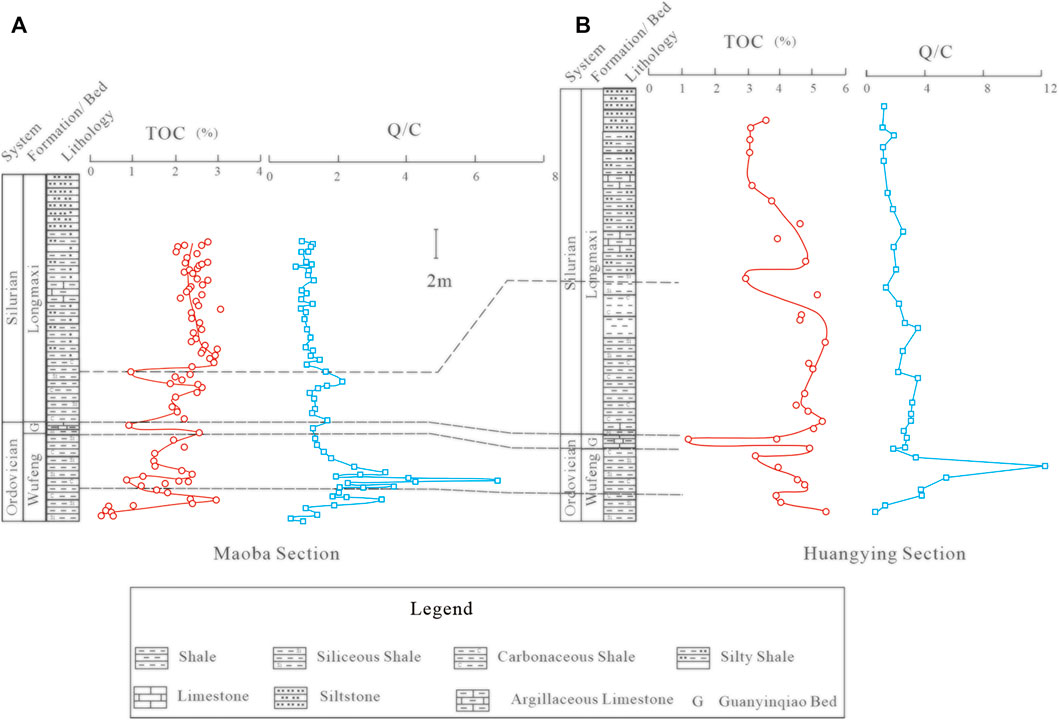
FIGURE 6. Vertical changing trend comparison of TOC and Q/C in shale samples between the Maoba section in Lichuan City and Huangying section in Chongqing City Guanyingqiao Bed.
Trace elements content
It is generally believed that the variation in trace elements in sedimentary rocks is closely related to the composition of provenance area, exchange reaction, and diagenesis process in sedimentary environment (Condie 1991). Also, the occurrence and enrichment of elements in shale are closely related to the sedimentary environment of rocks. Representative shale samples’ (34) trace elements (U, Th, V, Ni, Cr, Co) test results show that the average values of the six types of trace elements for the Huangying section are higher than those of the Maoba section, with the exception of Th. At present, many paleo-environmental indicators have been established according to the changes in trace elements (or ratios) (Bryn and David 1994; Wignall and Twitchett 1996; Zhu et al., 2002; Li and Chen 2003; Liu and Zhou 2007). When the U/Th ratio is higher than 1.25, the V/Cr is higher than 4.25, and the V/(V + Ni) is higher than 0.5, the sedimentary environment may be anaerobic. When the U/Th ratio is lower than 0.75, the V/Cr is lower than 2.0, and the V/(V + Ni) is lower than 0.45, the sedimentary environment may be oxygen rich. There was a sudden change in the Guanyingqiao Bed, especially in the Huangying section. The results show that when the Wufeng Formation is deposited, the study sections experienced paleo-redox change from oxygen rich to anoxic, and even euxinic, followed by an increase in the oxygen content. When the Guanyinqiao Bed deposited, the basin suddenly became shallower, and the paleo-redox changed to be oxygen enriched for high water energy, circulating oxygen enriched. In the earliest stage Silurian, when the Longmaxi Formation formed, the paleo-environment also changed from anoxic to oxic (Figure 7).
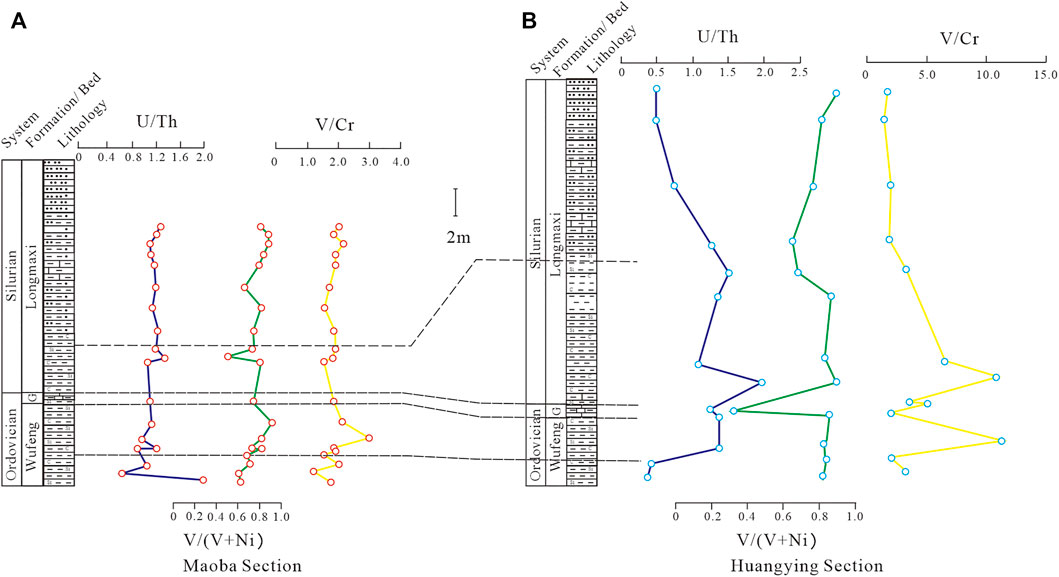
FIGURE 7. Vertical changing trend comparison of trace elements ratios in shale samples between the Maoba section in Lichuan City and Huangying section in Chongqing City.
Discussion
At present, it is generally accepted that during the Upper Ordovician Wufeng Formation to Lower Silurian Longmaxi Formation, the upper Yangtze region was surrounded among the paleo-uplifts in Central Sichuan, Guizhou Province, and Xuefeng Mountain, forming a semi-occluded stagnant basin (Guan, et al., 2021). Additionally, the two sections in this study were located near one of the sedimentary centers. Also, the overall paleo-environment of black shale was semi-deep to deep water shelf, where the input of terrigenous materials, especially terrigenous clastic quartz, was less, resulting in most of the black shale being siliceous shale as shown in Figure 5, and most of the siliceous shale was of authigenic origin, including authigenic quartz transforming from organic remains, secondary over growth of terrigenous quartz transforming from clay minerals, and micron quartz particle transforming from clay minerals. and so on (Guo et al., 2021). So, the total organic carbon content (TOC), quartz, clay minerals, and trace elements’ contents are essentially controlled by sedimentary environment, and their relative changes can be used as indicators to reflect sedimentary environment, especially paleo-water depth. Based on the high-density sampling of two field sections, this paper attempts to reveal the continuous variation of relative paleo-water depth.
The TOC in shale actually refers to the measured residual organic carbon in rocks, and its value reflects the hydrocarbon generation potential of rocks. The Silurian period was the most intense period of the crustal movement in Caledonian tectonic stage in geological history. The strong compression led to the expansion of the paleo-uplift area, which led to the forced transgression in the study area, and deposited a set of organic rich black shale sediments. Wei et al. (2017) proposed that there was a good correlation between TOC in sediments and paleo-water depth. So, we also draw the variation curve of TOC in these two sections to reflect changes in paleo-water depth. Larger values of TOC correspond to deeper water bodies and vice versa for deep water shelf environment.
The sections’ correlation map (Figure 6) shows that the TOC content changing the trend in the Maoba section is consistent with that of the Huangying section. As a whole, TOC content of the Guanyinqiao Bed is obviously smaller than that of the Wufeng Formation and Lower Longmaxi Formation, which is consistent with the previous research result that the main part of the Guanyinqiao Bed was shallow water sedimentation (Rong et al., 2011; Wang et al., 2016; Zhou et al., 2017). By comparing the two sections’ TOC content, the relative paleo-water depth of the strata experienced several cycles of deepening to shallowing (as shown in Figure 6). For the Guanyinqiao Bed, the paleo-water depth may suddenly and rapidly become shallower. Moreover, the average TOC content of the Huangying section in Chongqing is higher than that of the Maoba section in Lichuan, which may indicate that the water body in the Wulong area is deeper than that in the Maoba area in the lower part of the Wufeng Longmaxi Formation period.
Yi et al. (2018) proposed the parameter Q/C to reflect the change in relative paleo-water depth, especially suitable for deep-water shelf environment, where there is less input of terrestrial materials but strong biochemical effect. When Q/C increases, the water body becomes deeper and vice versa. In Figure 6, the variation trend of Q/C in the two sections is basically consistent, and the trends have good consistency with that of TOC content. Similarly, the Q/C of the Huangying section in Chongqing City is higher than that of the Maoba section in Lichuan City, which may indicate that the paleo-water depth in Chongqing area is deeper than that in Lichuan area since Late Cambrian to Early Silurian. This result is consistent with TOC content, which may indicate that the siliceous shale of the study section has a high content of biogenic quartz because the content of biological quartz is directly proportional to TOC (Figure 6).
It is shown that the trace elements’ changing trends of the two sections are basically similar (Figure 7). The vertical variation trends in U/Th, V/(V + Ni), and V/Cr of the two sections tend to be consistent. For one section, the variation trends in U/Th, V/Cr, and V/(V + Ni) are consistent with each other, too, and the paleo-redox changes are related with the paleo-water depth variations. During the later Ordovician period, when the Wufeng Formation deposited, the study area experienced a water depth change from relative deep facies to shallow marine, and paleo-redox changed from oxygen rich to anoxic, and even euxinic, followed by the increase in oxygen content. When the Guanyinqiao Bed deposited, the basin suddenly became shallower, and the deposition environment changed to be oxygen enriched for high water energy, circulating oxygen enriched. In the earliest stage Silurian, when the Longmaxi Formation formed, the paleo-water also suffered several changes in sea level, and the paleo-environment also changed from anoxic to oxic.
Through synthetic comparing and analyzing of the two sections, it is found that TOC, quartz/clay ratio (Q/C), and trace element ratios can reflect the changes in paleo-water change well, and the consistency among the three types of data is good, which can be used to verify with each other. The changing trends in those parameters might reflect the third–fourth-order sequence or system tract (Yi, et al., 2018): the strata from the Wufeng Formation, the Guanyingqiao Bed, and the Lower Longmaxi Formation are classified into two third-order sequences. The microfacies in the first sequence include the siliceous–argillaceous deepwater shelf, siliceous deep-water shelf, and calcareous–muddy shallow shelf microfacies. They mostly correspond to carbon-rich and high-silica lithofacies and high-carbon and high-silica lithofacies. The second sequence can be subdivided into the carbonaceous deepwater shelf, siliceous–argillaceous deepwater shelf, and some sandy–muddy deepwater shelf sediments, which correspond to the carbon-rich and high-silica lithofacies in the TST. In addition, the lower part in the HST is composed of muddy deepwater shelf, turbidite sand, and sandy–muddy deepwater shelf sediments that mainly correspond to high-carbon and high-silica lithofacies and high-carbon and medium-silica lithofacies. This can help to carry out fine stratigraphic correlation and be more reliable than a single parameter.
Mudstone and shale is one significant type of sedimentary rock, with the largest proportion of quartz content (Blatt, 1970). Quartz is the main component of the debris skeleton in shale, and its forming mechanism includes clastic quartz and authigenic quartz (Blatt, 1987). Also, the former study showed that quartz in the Wufeng Formation–Longmaxi Formation in South China had two sources, including eolian quartz input and authigenic quartz, and the latter one dominated (Ran et al., 2013). Siliceous organisms decompose and absorb SiO2 from seawater, and when they die, the SiO2 is reentered into the aqueous solution or precipitate directly (Qin et al., 2010). The clay mineral content decreases with the increase in transportation distance or water depth. The deeper the water is, the less the total content of clay minerals will be. In short, the Q/C may indicate the water depth to a certain degree. The quiet and deep-water shelf sedimentary environment, which is rich in silicon, provides a lot of silicon for the growth of siliceous organisms, and also plays a positive role in the burial and preservation of siliceous organisms after death. So, TOC and Q/C can show good consistency in siliceous shale.
The salty, alkaline seawater and the lower part of the stratified water body or below the sedimentary interface in reduction environment is conducive to the preservation of plankton organic matter and siliceous debris. Organic matter enriches in mudstone or shale (Hunt, 1996), and the organic matter combines with clay minerals; even some organic matter enters into the soil layers to form a very stable complex. Quartz and clay minerals are both important for the organic matter accumulation in shale. The contribution of quartz and clay minerals depend on the nature of shale. The organic matter is mostly associated with silicon, which is the most important form of marine source rock in South China. Traditionally, it was agreed that the TOC was increased with the clay minerals’ content. However, an opposite relationship was found between TOC and clay minerals in this study, and it is concluded that the TOC content was mostly contributed by the authigenic quartz, which is enriched and dominated in the study area.
At present, there are a few studies on the quantitative restoration of paleo-environment of black shale deposition at home and abroad. This paper proposes three indicators in trying to study the paleo-environment of the study area qualitatively, and the research results are basically consistent with the previous understanding, which also shows that these methods are reliable.
Conclusion
The lithofacies of the Wufeng–Longmaxi Formations shale in Huangying section include CM-1, S, S-2, S-3, and M-1, and the S-3 and CM-1 lithofacies dominate in the Maoba section. They both show good exploration prospects.
For the two sections, in the vertical changing trend comparison of TOC, Q/C, and trace element ratio, it was found that they have good consistency, and indexes can reflect the paleo-water depth and paleo-redox changes from the latest Ordovician to the earliest Silurian.
The vertical variation trends in U/Th, V/(V + Ni), and V/Cr of the two sections tend to be consistent. For a single section, the variation trends in U/Th and V/Cr are totally consistent with that of V/(V + Ni). Conclusively, for the deep-water shelf environment, larger values of TOC, higher Q/C correspond to bigger U/Th and V/Cr ratio, and the water is anoxic, or even euxinic. On the contrary, shallow water shelf environment with enriched oxygen is characterized by smaller values of TOC, lower Q/C, U/Th, and V/Cr ratio.
Data Availability Statement
The raw data supporting the conclusions of this article will be made available by the authors, without undue reservation.
Author Contributions
XY supervised the work and wrote the paper. YH wrote part of the manuscript. XJ and ZL helped in collecting the fresh samples in the field. JM contributed to revising the paper. All authors contributed to this work.
Funding
The paper is supported by National Natural Science Foundation of China (grant nos. 41772094 and 41702116) and the Project of Excellent Young and Middle-Aged Scientific and Technological Innovation Team of Hubei Province universities (grant no. T201905).
Conflict of Interest
The authors declare that the research was conducted in the absence of any commercial or financial relationships that could be construed as a potential conflict of interest.
Publisher’s Note
All claims expressed in this article are solely those of the authors and do not necessarily represent those of their affiliated organizations, or those of the publisher, the editors, and the reviewers. Any product that may be evaluated in this article, or claim that may be made by its manufacturer, is not guaranteed or endorsed by the publisher.
References
Blatt, H. (1970). Determination of Mean Sediment Thickness in the Crust: a Sedimentologic Method. Geol. Soc. America Bull. 81, 255–262. doi:10.1130/0016-7606(1970)81[255:domsti]2.0.co;2
Blatt, H. (1987). Perspectives; Oxygen Isotopes and the Origin of Quartz. J. Sediment. Res. 57, 373–377. doi:10.1306/212f8b34-2b24-11d7-8648000102c1865d
Bryn, J., and David, A. C. (1994). Comparison of Geochemical Indices Used for the Interpretation of Palaeo Redox Conditions in Ancient Mudstone. Chem. Geology. 111, 111–129. doi:10.1016/0009-2541(94)90085-X
Chen, P. F. (1997). Significances of Depth Stratification of Late Tertiary Plankton Foraminifera of basin in southeastern Hainan Province. Geol. Sci. Technology Inf. 16 (2), 38–42.
Condie, K. C. (1991). Another Look at Rare Earth Elements in Shales. Geochimica et Cosmochimica Acta. 55 (9), 2527–2531. doi:10.1016/0016-7037(91)90370-k
Deng, X., Kang, Z. H., Peng, Y. Y., Xiao, H. F., and Han, H. Y. Yu. X. D. (2018). Characteristics of Shale Elements in Ordovician Wufeng Formation in Southern Part of Sichuan Basin and its Significance to Paleoenvironment. Coal Technology. 37 (04), 104–106.
Douglas, R. G. (1972). Paleozoogeography of Late Cretaceous Planktonic Foraminifera in North America. J. Foraminiferal Res. 2 (1), 14–34. doi:10.2113/gsjfr.2.1.14
Gamero-Diaz, H. C., and Miller, R. L. (2012). sCore: A Classification Scheme for Organic Mudstones Based on Bulk Mineralogy. AAPG. Search and Discovery Article # 40951, 18.
Guan, Q. Z., Dong, D. Z., Zhang, H. L., Sun, S. S., Zhang, S. R., and Guo, W. (2021). Types of Biogenic Quartz and its Coupling Storage Mechanism in Organic-Rich Shales: A Case Study of the Upper Ordovician Wufeng Formation to Lower Silurian Longmaxi Formation in the Sichuan Basin, SW China. Pet. Exploration Development. 48 (4), 700–709. doi:10.1016/s1876-3804(21)60068-x
Guo, L. Y., Zhang, S. W., Xie, X. N., Li, Z., Huang, C., and Chen, B. (2017). Geochemical Characteristics and Organic Matter Enrichment of the Dongyuemiao Member Mudstone of Lower Jurassic in the Western Hubei- Eastern Chongqing. Earth Sci. 42 (7), 1235–1246. doi:10.3799/dqkx.2017.100
Guo, W., Dong, D. Z., Li, M., Sun, S. S., Guan, Q. Z., and Zhang, S. R. (2021). A Case Study on the First Submember of the First Member of Lower Silurian Longmaxi Formation in the southeastern Sichuan Basin and its Periphery. Nat. Gas Industry. 41 (2), 65–74. doi:10.3787/j.issn.1000-0976.2021.02.008
He, W. J., Zhang, J. X., Zuo, Q. M., Wang, Y. H., Hu, D. S., and Su, Y. F. (2013). The Application of Micropaleontology in High-Resoulution Sequence Stratigraphy and Paleoenvironmental Reconstruction: A Case Study of the Yinggehai Qiongdongnan Basin. J. Stratigr. 37 (4), 410–416. doi:10.19839/j.cnki.dcxzz.2013.04.003
Hunt, J. M. (1996). Petroleum Geochemistry and Geology. Second. New York: W H Freeman and Company, 1–100.
Jiao, K., YeRan, Y. B., Liu, S., Ran, B., Deng, B., Li, Z., et al. (2018). Characterization and Evolution of Nanoporosity in Superdeeply Buried Shales: A Case Study of the Longmaxi and Qiongzhusi Shales from MS Well #1, north Sichuan basin, china. Energy Fuels. 32 (1), 191–203. doi:10.1021/acs.energyfuels.7b02932
Li, H., Lu, J. L., Li, R. L., Wang, B. L., Xu, W., Zuo, Z. X., et al. (2017). Generation Paleoenvironment and its Controlling Factors of Lower Cretaceous Lacustrine Hydrocarbon Source Rocks in Changling Depression, South Songliao Basin. Earth Sci. 42 (10), 1774–1786. doi:10.3799/dqkx.2017.539
Li, J. L., and Chen, D. J. (2003). Summary of Quantified Research Method on Paleosalinity. Pet. Geology. Recovery Efficiency. 10 (5), 1–3. doi:10.13673/j.cnki.cn37-1359/te.2003.05.001
Li, S. J., Zheng, D. S., Jiang, Z. X., Hu, B., Wang, J. X., and Jiao, Y. H. (2005). Water Depth of Palaeo-Lacustrine basin Recovered by Dominance Diversity of Ostracoda: An Example from Sedimentary Period of the Member 3 of Shahejie Formation of Paleogene in Dongying Sag, Shandong Province. J. Palaeogeogr. 7 (3), 399–404.
Li, Y. J., Zhao, S. X., Huang, Y. B., Zhang, L. H., Zhang, K., and Tang, H. M. (2013). The Sedimentary Micro-facies Study of the Lower Cambrian Qiongzhusi Formation in Southern Sichuan Basin. Acta Geologica Sinica. 87 (08), 1136–1148. http://www.geojournals.cn/dzxb/ch/index.aspx
Liu, G., and Zhou, D. S. (2007). Application of Microelements Analysis in Identifying Sedimentary Environment: Taking Qianjiang Formaition in the Jianghan Basin as an Example. Pet. Geology. Exp. 29 (3), 307–310. doi:10.11781/sysydz200703307
Qin, J. Z., Shen, B. J., Fu, X. D., Tao, G. L., and Teng, G. R. (2010). Ultramicroscopic Organic Petrology and Potential of Hydrocarbon Generation and Expulsion of Quality marine Source Rocks in South China. Oil Gas Geology. 31 (6), 826–837. doi:10.1016/S1876-3804(11)60008-6
Qiu, J. W. (2015). Shale Lithofacies Characteristics Study of Wufeng-Longmaxi Formation in Eastern Maginal Part of Sichuan Basin. PhD thesis. Chengdu University of Technology.
Ran, B., Liu, S. G., Sun, W., Yang, D., Wang, S. Y., Ye, Y. H., et al. (2013). Redefinition of Pore Size Characteristics in Wufeng Formation-Longmaxi Formation Black Shale of Qilongcun Section in Southern Sichuan Basin, China. J. Chengdu Univ. Technology(Science Technology Edition). 4 (5), 532–542. doi:10.3969/j.issn.1671-9727.2013.05.05
Robert, G. D., and Samuel, M. S. (1978). Oxygen Istopic Evidence for the Depth Stratification of Tertiary and Cretaceous Planktic Foraminifera. Mar. Micropaleontology. 3, 175–196. doi:10.1016/0377-8398(78)90004-X
Sliter, W. V. (1972). Cretaceous Foraminifers-Depth Habitats and Their Origin. Nature. 239 (5374), 514–515. doi:10.1038/239514a0
Sun, Z. F. (2016). Sedimentary and Geochemistry Characteristics of Coal-Bearing Black Shales of Permo-Carboniferous in the Eastern Ordos Basin. M.S. Thesis. China University of Geosciences.
Wang, Y. M., Dong, D. Z., Huang, J. L., Li, X. J., and Wang, S. (2016). Guanyinqiao Member Lithofacies of the Upper Ordovician Wufeng Formation Around the Sichuan Basin and the Significance to Shale Gas Plays, SW China. Pet. Exploration Development. 43 (1), 42–50. doi:10.1016/s1876-3804(16)30005-2
Wang, Y. M., Dong, D. Z., Li, X. J., Huang, J. L., Wang, S. F., and Wu, W. (2015). Stratigraphic Sequence and Sedimentary Characteristics of Lower Silurian Longmaxi Formation in the Sichuan Basin and its Peripheral Areas. Nat. Gas Industry. 35 (03), 12–21. doi:10.1016/j.ngib.2015.07.014
Wang, Y. M., Wang, H. K., Zhang, C. C., Li, X. J., and Dong, D. Z. (2017). Fracture Pore Evaluation of the Upper Ordovician Wufeng to Lower Silurian Longmaxi Formations in Southern Sichuan Basin, SW China. Pet. Exploration Development. 44 (4), 531–539. doi:10.1016/s1876-3804(17)30065-4
Wei, Y. Q., Wang, C. Y., Meng, X. H., Liu, W. W., Zhou, Y., and Chang, H. L. (2017). Organic Matter Analysis of Surface Sediment in Buha Estuary Region and its Comparative Sedimentary Studies Significance. J. Lake Sci. 29 (5), 1254–1264. doi:10.18307/2017.0524
Wignall, P. B., and Twitchett, R. J. (1996). Oceanic Anoxia and the End Permian Mass Extinction. Science. 272 (5265), 1155–1158. doi:10.1126/science.272.5265.1155
Xian, B. Z., ZhuYue, X. M. D. L., and Zheng, X. J. (2014). Current Hot Topics and Advances of Sedimentary Studies: A Summary from 19th International Sedimentological Congress. J. Palaeogaography. 16 (6), 816–826. doi:10.7605/gdlxb.2014.06.065
Xie, G. L. (2020). Pore Structure Characteristics of the Lower Paleozoic marine Shale in the Sichuan Basin and Their Relattionships with Burial Depth of Shale. PhD thesis. Chengdu University of Technology.
Yan, J.-F., Men, Y.-P., Sun, Y.-Y., Yu, Q., Liu, W., Zhang, H.-Q., et al. (2016). Geochemical and Geological Characteristics of the Lower Cambrian Shales in the Middle-Upper Yangtze Area of South China and Their Implication for the Shale Gas Exploration. Mar. Pet. Geology. 70, 1–13. doi:10.1016/j.marpetgeo.2015.11.010
Yao, M. J., Bao, H. Y., Ding, Q., Long, Y. K., Liu, C., and Wang, Y. C. (2016). Stratigraphic and Sedimentary Characteristics of Wufeng-Longmaxi Formation in the Western Hunan-Hubei Region. South. China Geology. 32 (02), 191–197. doi:10.3969/j.issn.1007-3701.2016.02.012
Yi, D. X. (2020). Sedimentary Microfacies and Sedimentary Enviroment Evolution of the Black Shale Section of Wufeng Formation-Longmaxi Formation in Changning Area. PhD thesis. Chengdu University of Technology.
Yi, X. F., Zhao, L., Duan, T. Z., Huang, Y. F., and Chen, B. (2018). Shale Facies from the Wufeng-Lower Longmaxi Formations in the Huangying Section of Wulong County, southeastern Sichuan Basin, China. Interpretation. 6 (4), 133–151. doi:10.1190/int-2018-0026.1
Zhang, G. W., Guo, A. L., Wang, Y. J., Li, S. Z., Dong, Y. P., and Liu, S. F. (2013). Tectonics of South China Continent and its Implications. Sci. China. 56, 1804–1828. doi:10.1007/s11430-013-4679-1
Zhang, J. L., and Zhang, X. (2006). The Element Geochemical Features of Ancient Oceanic Sedimentary Environments in the Silurian Period in the Tarim Basin. Periodical Ocean Univ. China. 36 (2), 200–208. doi:10.1007/s11442-006-0415-5
Zhang, Q., Liang, F., Wang, H. Y., Lei, Z. A., and Qi, L. (2018). Elements Geochemistry and Paleo-Sedimentary Significance: A Case Study of the Wufeng-Longmaxi Shale in Southeast Chongqing. J. China Univ. Mining&Technology. 47 (2), 380–390. doi:10.13247/j.cnki.jcumt.000725
Zheng, Y. D., Lei, Y. H., Zhang, L. Q., Wang, X. Z., Zhang, L. X., Jiang, C. F., et al. (2015). Characteristics of Element Geochemistry and Paleosedimentary Environment Evolution of Zhangjiatan Shale in the Southeast of Ordos Basin and its Geological Significance for Oil and Gas. Nat. Gas Geosci. 26 (7), 1395–1404. doi:10.11764/j.issn.1672-1926.2015.07.1395
Zhong, J. H., Li, Y., Shao, Z. F., Chen, B., Ni, L. T., Xiao, S. M., et al. (2015). The Ultr-Environment Lake of Middle Sha-3 Formation During Paleogene in Dongying Sag, NE China. Geological Journal of China Universities 21 (2), 320–327. doi:10.16108/j.issn1006-7493.2013160
Zhou, Y. X., Ding, J., Yu, Q., Wang, J., Men, Y. P., Xiong, G. Q., et al. (2017). Sedimentary and Organic Carbon Isotopic Characteristics of the Kuanyinchiao Member in Northeastern Chongqing and its Regional Correlation. Acta Geologica Sinica. 91 (5), 1097–1107. doi:10.1111/1755-6724.13281
Zhou, Z., Zhai, G. Y., Shi, D. S., Wang, S. J., GuoLiu, T. X. Y. M., and Wang, H. (2019). Shale Gas Reservoir Geology of the Upper Ordovician Wufeng Formation-Lower Silurian Longmaxi Formation in Western Hubei and Northeastern Chongqing. Pet. Geology. Exp. 41 (1), 1–9. doi:10.11781/sysydz201901001
Zhu, C. L. (2019). Enrichment Mechanism of Organic Matter and Depositional Environment of Longmaxi Black Shale in Southern Formation of Sichuan Basin. Master’s thesis. Guizhou University.
Zhu, D. Y., Wang, X. J., Hao, X. F., Zhu, D. S., Wang, Y., Jiang, X. F., et al. (2016). Study on Sequence Stratigraphic Division of Oil Shale in Dongying Sag. Pet. Geology. Recovery Efficiency. 23 (2), 52–56. doi:10.13673/j.cnki.cn37-1359/te.20151215.003
Zhu, R. K., Guo, H. L., He, D. B., Luo, Z., and Shao, L. Y. (2002). The REE Geochemical Characteristics of Carboniferous Mudstone in Northwest Area. Geoscience. 16 (2), 131–136.
Keywords: black shale, shale oil, shale gas, paleo-environment, western Hubei and eastern Chongqing
Citation: Yi X, Ji X, Huang Y, Liu Z and Meng J (2022) Black Shale Paleo-Environmental Reconstructions: A Geochemical Case Study of Two Ordovician–Silurian Boundary Sections in Middle Yangtze Area, China. Front. Earth Sci. 10:842752. doi: 10.3389/feart.2022.842752
Received: 24 December 2021; Accepted: 31 January 2022;
Published: 09 March 2022.
Edited by:
Peng Cheng, Guangzhou Institute of Geochemistry (CAS), ChinaReviewed by:
Li Tian, China University of Geosciences Wuhan, ChinaJianhua Zhao, China University of Petroleum (East China), China
Wei Wu, Henan Polytechnic University, China
Copyright © 2022 Yi, Ji, Huang, Liu and Meng. This is an open-access article distributed under the terms of the Creative Commons Attribution License (CC BY). The use, distribution or reproduction in other forums is permitted, provided the original author(s) and the copyright owner(s) are credited and that the original publication in this journal is cited, in accordance with accepted academic practice. No use, distribution or reproduction is permitted which does not comply with these terms.
*Correspondence: Xuefei Yi, eXhmQHlhbmd0emV1LmVkdS5jbg==
 Xuefei Yi
Xuefei Yi Xia Ji1
Xia Ji1